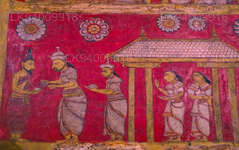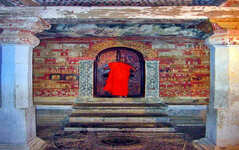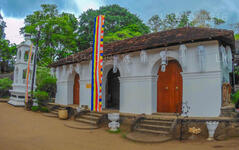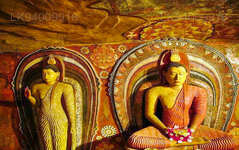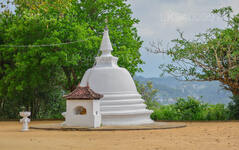
Kandy, pittoresca città dello Sri Lanka centrale, è rinomata per il suo ricco patrimonio culturale, i vivaci festival e la bellezza paesaggistica. Immersa tra lussureggianti colline, ospita il Tempio della Reliquia del Dente di Buddha, patrimonio mondiale dell'UNESCO, e offre un'affascinante combinazione di storia e splendore naturale.
Kandy, pittoresca città dello Sri Lanka centrale, è rinomata per il suo ricco patrimonio culturale, i vivaci festival e la bellezza paesaggistica. Immersa tra lussureggianti colline, ospita il Tempio della Reliquia del Dente di Buddha, patrimonio mondiale dell'UNESCO, e offre un'affascinante combinazione di storia e splendore naturale.
Degaldoruwa Raja Maha Vihara
Amongst the rocky slopes and green valleys of rural Kandy lies a hidden treasure; the Degaldoruwa Raja Maha Vihara. This temple awes those who view it with its incredible Kandyan era frescoes. Construction of the temple began in the late 1770s under the reign of King Kirti Sri Rajasinha and was completed under the reign of his brother Rajadhi Rajasinha years later.
Legend
According to folklore a farmer was exploring the area and found a crevice between two rocks. On venturing into space he found a cave with a pile of golden sickles. The farmer was delighted with his discovery but feared retribution from some strange power. So he simply took only one sickle every morning and, after using it in his fields, returned it in the evening. His fields yielded an extremely healthy harvest and the farmer attributed it to the golden sickle. But then he became greedy. After all, he had been taking the sickles every day and there had been no ill effects, and there was a whole pile of them. So on the very last day of the harvest, he took two sickles instead of one and did not return one of them.
But unknown to the farmer, there had indeed been a guardian for the treasure. The guardian noticed the farmer taking the sickles, but kept quiet as he always returned them. On the day that the farmer took one sickle for himself, the guardian saw it at once and confronted him in his home. The terrified farmer immediately rushed to the crevice and returned the golden sickle that he had stolen. The guardian, who had been disappointed, then sealed the crevice by fusing the two rocks together. However, the villagers got to know this story and informed the king, Kirti Sri Rajasinha; who then ordered that the cave be found and a temple erected in it.
The Structure
- The temple is hollowed out of a 40 foot rock outcrop extending a natural cave. It consists of an elegant rock shelter with two roofed antechambers in front; a drummers’ hall and an image house; and the main shrine room cut into the rock itself. The two antechambers are constructed outside the rock outcrop and have wooden roofs.
- The architecture is unusual for the period as the drummers’ hall is not usually attached to the main temple.
- The image house is located through a set of old wooden doors, situated under a carved wooden Dragon Arch. It preserves a moonstone and a sequence of elaborate and colorful paintings showing scenes from four Jātaka tales, which tell the stories of the previous lives of Buddha.
- The door of the shrine room is banded with metal and once had jewels embedded within it. The inner walls of the shrine are completely covered in paintings; including the door.
- In addition to this main structure, there is a bo tree and a stupa on a plateau on the summit of the rocky outcrop above the temple. They can be reached by stairs carved into the temple.
The Frescoes
The paintings of Degaldoruwa, which are supposed to be some of the best of the Kandyan era, are believed to be the work of four ‘Sittara’ artists. The finest of these paintings grace the ceiling of the temple; ‘Mara Yudde’, an artistic depiction of Buddha’s internal spiritual battle against Māra, the demon of death, rebirth, and desire.
The murals are unique in that all the elements; the people, the trees and the animals; are a uniform size and only the front views of ]people are shown. The trees have a stylized form, with their branches and leave spreading out to either side. The individual elements, such as the adornments on the elephants and the uniforms of the attendants, are portrayed in great detail. All of the colors used by the artists in the murals were created from the barks
Informazioni sul distretto di Kandy
Il distretto di Kandy si trova nella provincia centrale dello Sri Lanka. Uno dei sette siti Patrimonio dell'Umanità dello Sri Lanka, Kandy un tempo era la dimora dei re di Kandy nel XVI secolo e una fonte di tutta la musica, l'arte, l'artigianato e la cultura del paese. A circa 129 km da Colombo, Kandy è incastonata in un terreno collinare e tutti gli occhi sono attratti dal centro della città, dove il lago di Kandy costituisce un elemento affascinante. Kandy conserva un grande significato religioso per lo Sri Lanka, perché è in questa affascinante città che si trova il Dalada Maligawa o "Tempio del Dente", all'interno del quale giace ben custodita la sacra reliquia del dente del Signore Buddha. Il Giardino Botanico Reale di Peradeniya si trova a circa 5 km a ovest del centro città a Peradeniya ed è visitato da 1,2 milioni di persone all'anno. È il più grande giardino botanico dell'isola. L'Udawatta Kele (Foresta di Udawatta) è un santuario protetto situato nel cuore della città, appena a nord del Tempio del Dente. Kandy è una città a maggioranza singalese; vi sono comunità consistenti appartenenti ad altri gruppi etnici, come Mori e Tamil. Kandy è seconda solo a Colombo, il centro dell'economia dello Sri Lanka. Molte importanti cooperative hanno grandi filiali a Kandy e molte industrie, tra cui tessile, arredamento, informatica e gioielleria, si trovano qui. Molti centri di ricerca agricola si trovano in città. È una fonte di tutta la musica, l'arte, l'artigianato e la cultura del paese. A circa 129 km da Colombo, Kandy è immersa in un terreno collinare e tutti gli occhi sono attratti dal centro della città, dove il Lago di Kandy costituisce un elemento incantevole. Kandy conserva un grande significato religioso per lo Sri Lanka, perché è in questa affascinante città che si trova il Dalada Maligawa o Tempio del Dente, all'interno del quale è ben custodita la sacra reliquia del dente del Signore Buddha.
Informazioni sulla provincia centrale
La Provincia Centrale dello Sri Lanka è costituita principalmente da un territorio montuoso. La provincia ha una superficie di 5.674 km² e una popolazione di 2.421.148 abitanti. Alcune delle città principali includono Kandy, Gampola (24.730), Nuwara Eliya e Bandarawela. La popolazione è un mix di cingalesi, tamil e mori. Sia la capitale collinare Kandy che la città di Nuwara Eliya si trovano nella Provincia Centrale, così come Sri Pada. La provincia produce gran parte del famoso tè di Ceylon, piantato dagli inglesi negli anni '60 dell'Ottocento dopo che una devastante malattia distrusse tutte le piantagioni di caffè della provincia. La Provincia Centrale attrae molti turisti, con città collinari come Kandy, Gampola, Hatton e Nuwara Eliya. Il Tempio del Dente o Dalada Maligawa è il principale luogo sacro della provincia di Central. Il clima è fresco e molte zone intorno ai 1500 metri hanno spesso notti fredde. I pendii occidentali sono molto umidi, con precipitazioni che in alcuni punti raggiungono quasi i 7000 mm all'anno. I pendii orientali appartengono alla zona medio-secca, in quanto ricevono pioggia solo dal monsone di nord-est. Le temperature variano dai 24 °C di Kandy ai soli 16 °C di Nuwara Eliya, che si trova a 1.889 m sul livello del mare. Le montagne più alte dello Sri Lanka si trovano nella Provincia Centrale. Il territorio è prevalentemente montuoso, con profonde valli che lo attraversano. Le due principali regioni montuose sono il massiccio centrale e la catena delle Knuckles, a est di Kandy.


